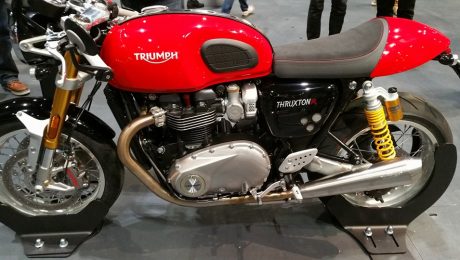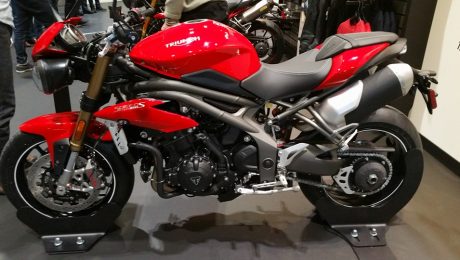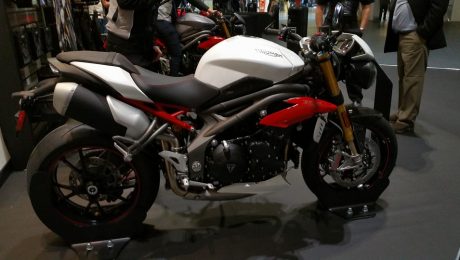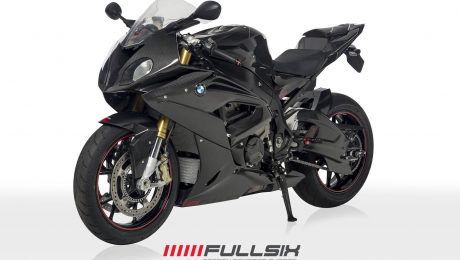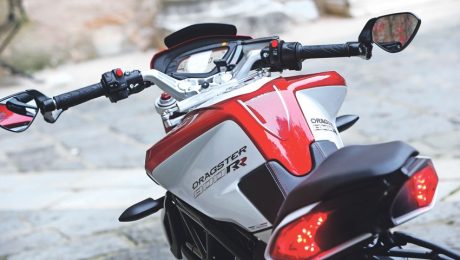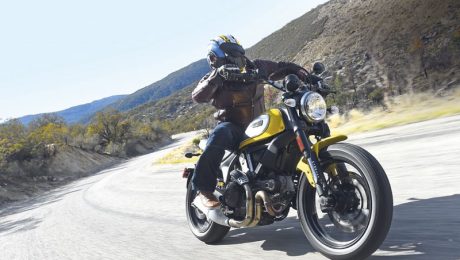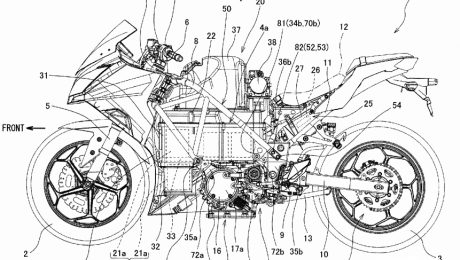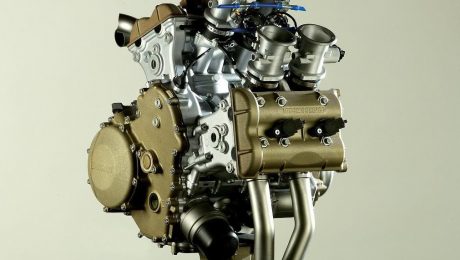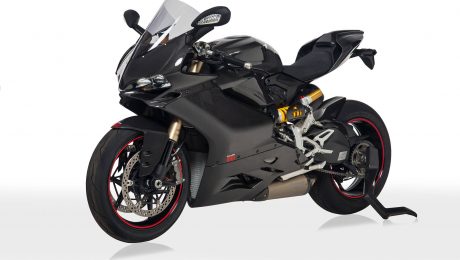2016 Triumph Thruxton R
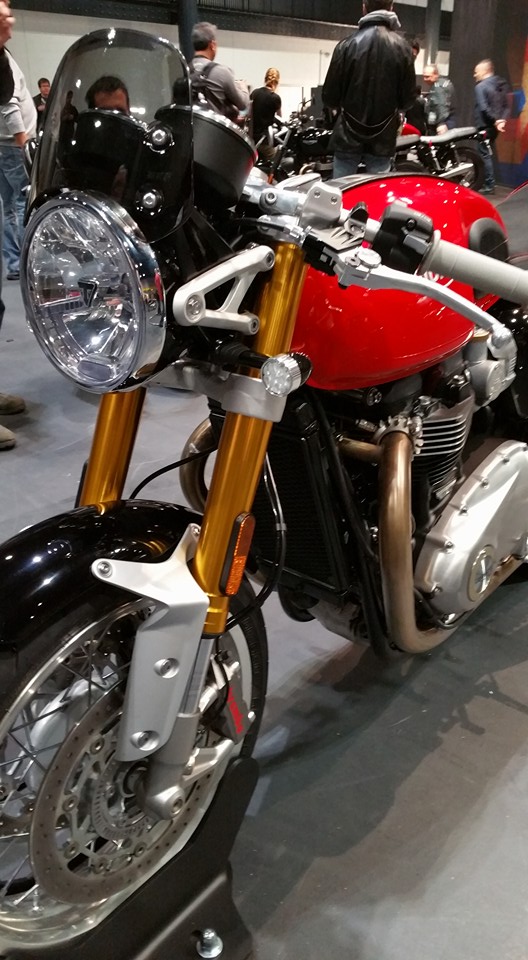
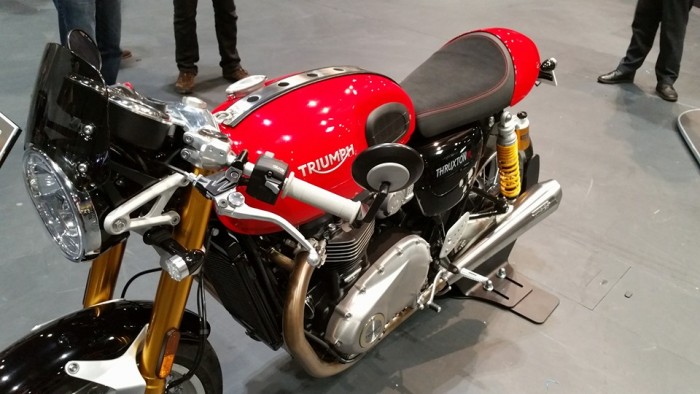
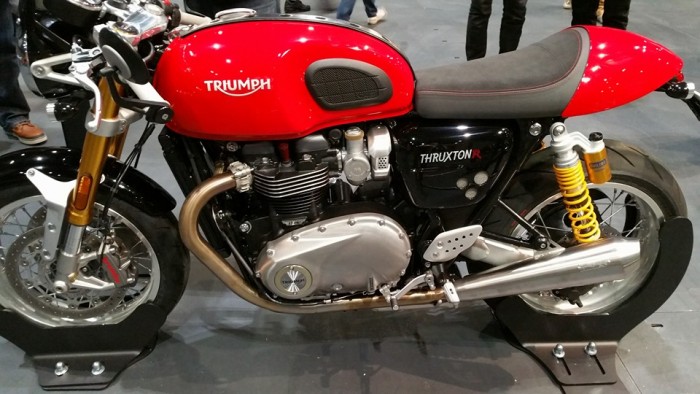

2016 Triumph Thruxton and Thruxton R first pics of all-new models! 64% more torque and killer 1960s looks!
Triumph has launched the new Thruxton and Thruxton R as part of the 2016 Bonneville range, which also includes the brand new Street Twin and the upgraded T120 and T120 Black.
The Thruxton is the bike that was featured in the recent Outlaws film starring David Beckham. It is edgier and sportier than the other models in the new range. So if you wanted something racier than the T120 or more powerful than the Street Twin then here’s your answer: the new Thruxton and Thruxton R.
The new Thruxton builds on the rich heritage of Triumph bikes named after the legendary 500-mile Thruxton endurance race series. Back in the day, it was the Triumphs that dominated it, and also broke the first 100mph lap at the Isle of Man TT. No wonder then that the Bonneville Thruxton racers inspired a generation of teenage café racers and custom special builders.
The new Thruxton and Thruxton R for 2016 are striking machines. They combine the classic racer look with modern touches, and seeing them in the flesh, it takes some self-control not to jump on one and break for freedom. Trust me, the photos don’t do them justice. The bikes simply ooze style, elegance and a slightly unnerving promise of raw power.
Engine
Triumph describes the other engines in the new Bonneville line-up as ‘high torque’. They refer to the Thruxton engine as ‘high power’. And that’s the clue if anyone needed it; this is a full-blooded modern-day café racer, a sports classic built for speed and power as much as looking uber-cool outside the Ace café.
The 1200cc, eight-valve, parallel twin engine that powers both the Thruxton and Thruxton R delivers a claimed peak torque figure of 112Nm at 4,950rpm – a whopping 62% more than the previous generation 865cc engine (69Nm at 5,800rpm). Triumph has not confirmed the bhp details yet, but with the increase in engine size, this should go up quite nicely too.
As with the T120 bikes and the Street Twin, the new Thruxton engine is liquid-cooled to meet the new Euro4 emissions requirements. The cutting-edge liquid cooling system has been carefully integrated to minimise its visual impact – it looks the part. It also enhances fuel efficiency, which is never a bad thing.
The six-speed engine features a lighter crank, higher compression and a unique airbox. Triumph’s next generation ride-by-wire fuel-injection is fed by authentically styled twin throttle bodies that take nothing away from the classic looks of the bike.
The twin upswept exhausts have reverse-megaphone end cans that deliver a beautiful, rich exhaust note to match the bike’s looks. The pipes are finished in chrome on the Thruxton and brushed stainless steel on the Thruxton R.
Handling
Both the Thruxton and Thruxton R have new chassis and suspension, and according to Triumph this is all about sharp handling that really delivers on its café racer looks. Sitting on the bike, the riding position is surprisingly pleasant and natural, despite the low bars and the racer looks. Apparently this is 100% intentional. We haven’t had a chance to ride the bikes yet, but as soon as we do, we’ll let you know exactly what they’re like on the road (or track for that matter).
The bikes have sporting ergonomics, clip-on bars, fully adjustable suspension and 17-inch front wheel – all to ensure good handling and agility and, of course, a thrilling ride.
The Thruxton R is an upgraded version of the Thruxton with twin floating Brembo discs, racing Brembo monobloc callipers, Brembo master cylinder, race-bred, fully-adjustable Showa big piston forks, fully-adjustable Öhlins twin rear shocks and Pirelli Diablo Rosso Corsa tyres.
The new Thruxton and Thruxton R may look like classic racers but they feature a full suite of rider-focused technology, as Triumph puts it “sensitively integrated and without compromise to maintain its authentic Bonneville style and character”.
The modern technology that the Thruxton and Thruxton R come with includes variable anti-lock braking system (ABS), ride-by-wire throttle, traction control, slip-assist clutch and three rider modes (rain, road and sport). There’s also LED lights, USB socket and stylish twin clocks, controlled by elegant and simple switchgear.
Style
Even without resorting to the accessories that Triumph offers, the Thruxton and Thruxton R have all the styling elements of modern café racers covered. Both bikes have a ‘flip-top’ Monza-style fuel cap (a first on any modern production bike, according to Triumph), bullet seat and lightweight aluminium bar-end mirrors, wheel rims and swinging arm. The Thruxton R also features an additional painted seat cowl, polished top yoke, aluminium tank strap and clear anodised aluminium swinging arm.
What is striking about these bikes is the level of detail and the high-quality finish that is evident in all components. Everything from the flawless twin-skinned pipes to the elegant badges breathes elegance. And little touches, such as the red spark plug cover show that everything has been thought through to create both a high-performing and a highly-cultured machine.
The Thruxton comes in three colour choices: – Jet Black – Pure White, with a black tank stripe – Competition Green, with a metallic gold tank stripe.
The Thruxton R comes in two colour choices: – Diablo Red – Silver Ice.
Customising the Thruxton and Thruxton R
Triumph has seen potential in the growing trend of custom bikes and these new Bonnies come with a host of factory accessories, 160 for the Thruxton and Thruxton R alone, to be precise. The range covers everything from sculpted cockpit fairing and exhausts from Vance & Hines to bullet indicators and lower clip-on handlebars.
There are also three ‘inspiration kits’ that can be fitted at the dealers or in your own garage to instantly change the look of the bike. The options available for the Thruxton models are:
The Track Racer inspiration kit
The Track Racer kit features a host of competition-inspired accessories, including: – Sculpted cockpit fairing with lower clip-on handlebars – Single painted seat cowl (only for the Thruxton as already standard on Thruxton R) – Rear mudguard removal kit with compact light – Compact LED Indicators – Vance & Hines slip-on silencers – Knurled handlebar grips – Leather tank strap.
The Café Racer inspiration kit Bringing the full-on café racer style to the Thruxton and Thruxton R, including: – Rear mudguard removal kit with compact light – Vance & Hines exhausts – Lower clip-on handlebars
– Short tinted fly-screen – Compact LED indicators
– Single painted seat cowl (only for the Thruxton as standard already on Thruxton R)
– Signature Triumph rubber knee pads
– Knurled handlebar grips
– Leather tank strap.
Performance race kit for the Thruxton R In 2016 Triumph will launch a unique Triumph race kit only for the Thruxton R, that’s been specifically designed and developed for competition use and closed-circuit racing. The Factory Race kit will take the standard engine performance to an even higher level, with more power and torque, and lower overall weight.
source: morebikes
- Published in Motorcycles
2016 Triumph Speed Triple S
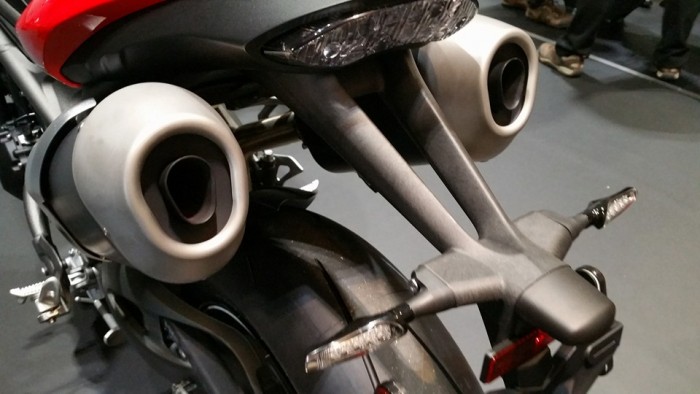
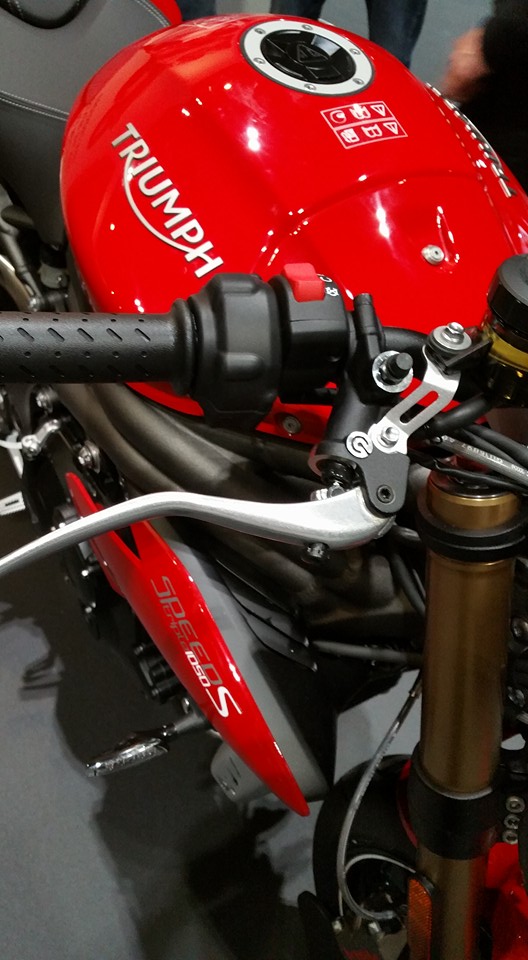
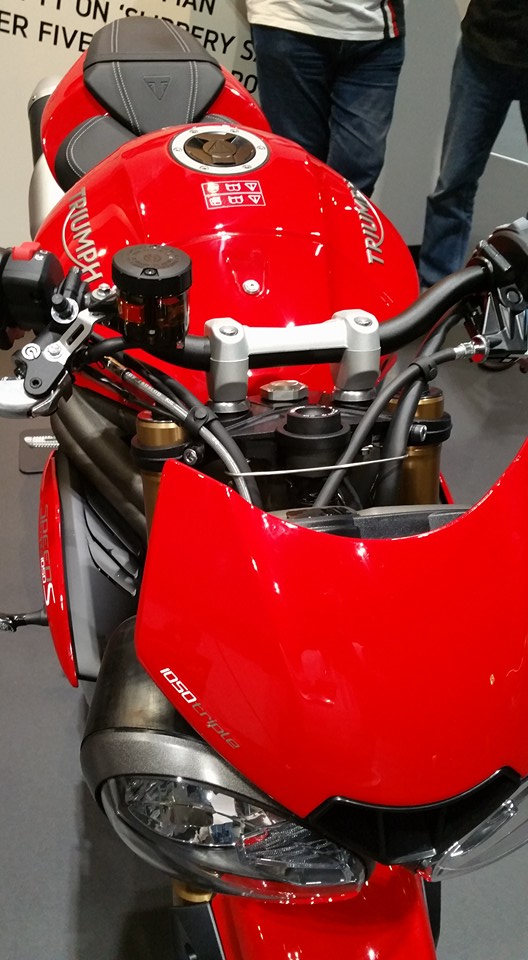
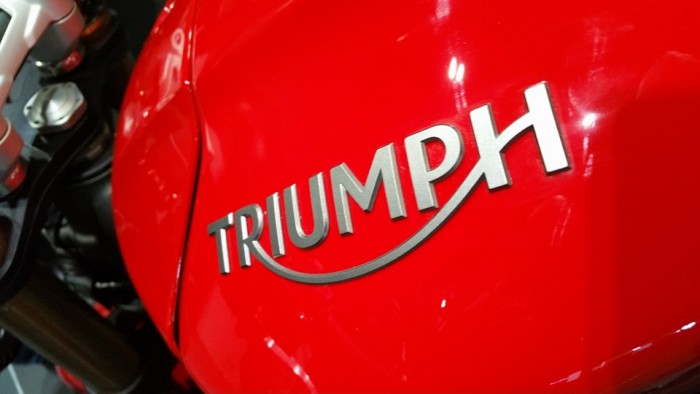

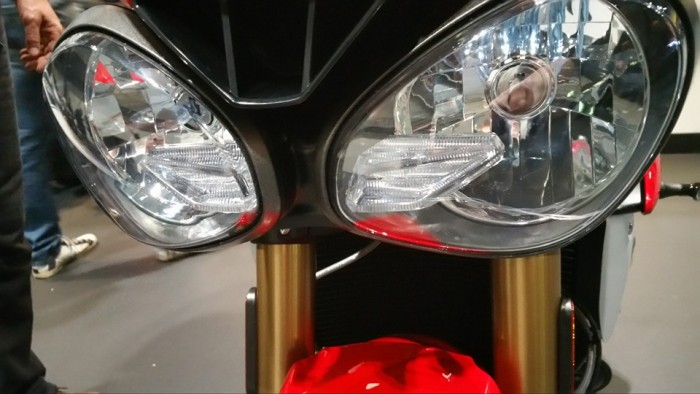
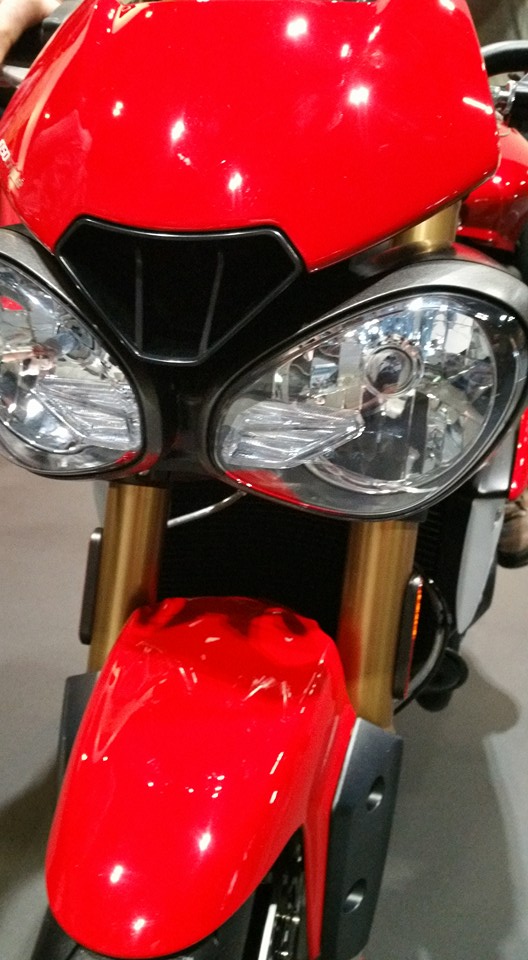
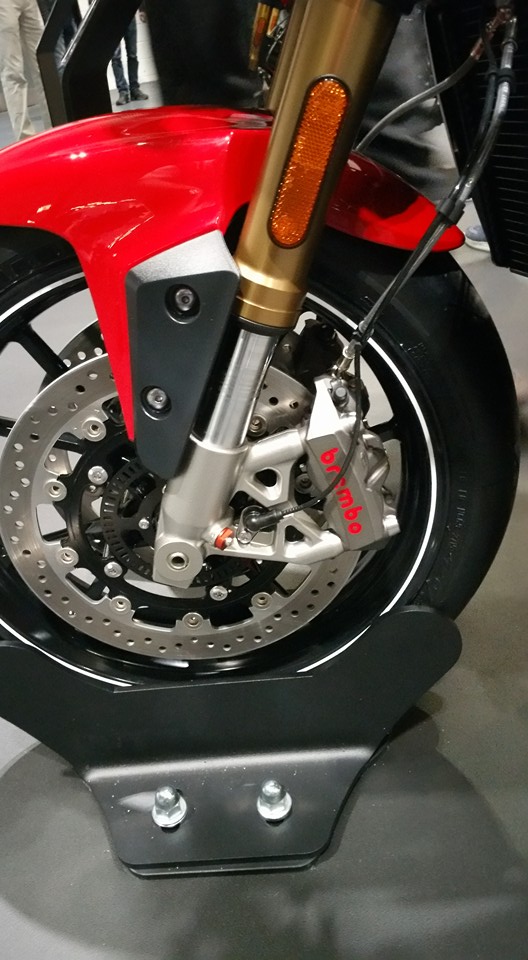
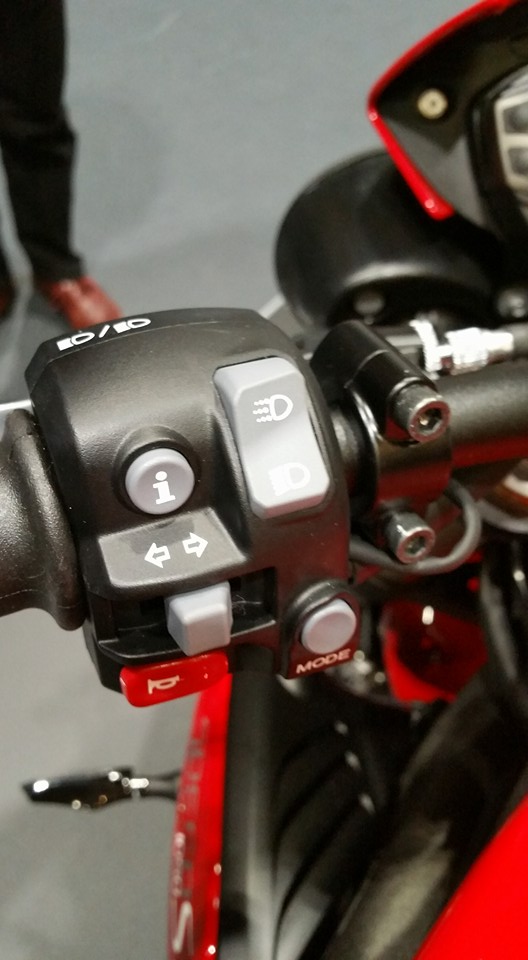
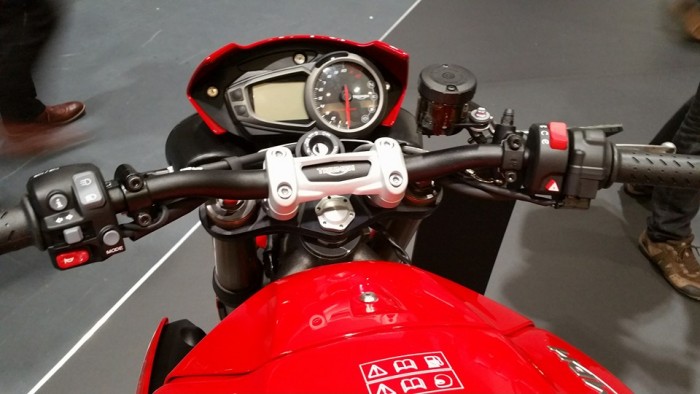
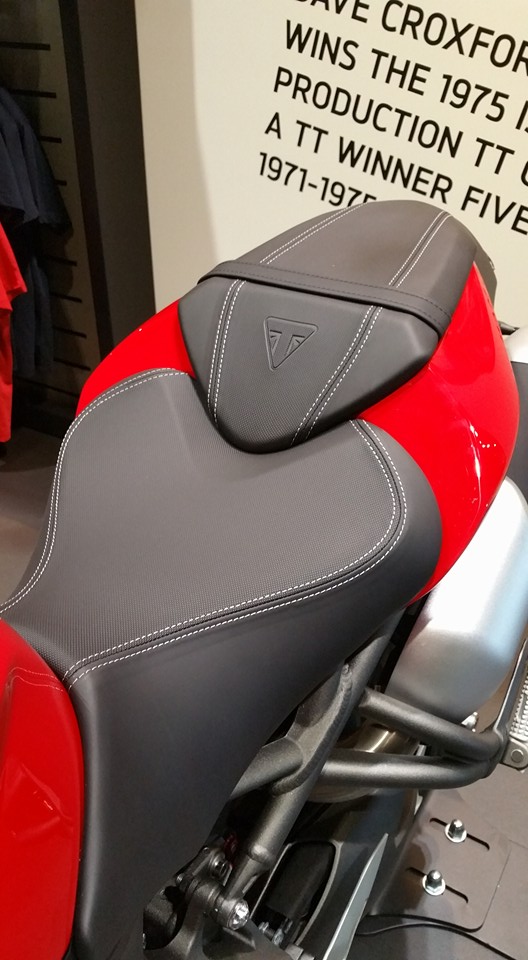
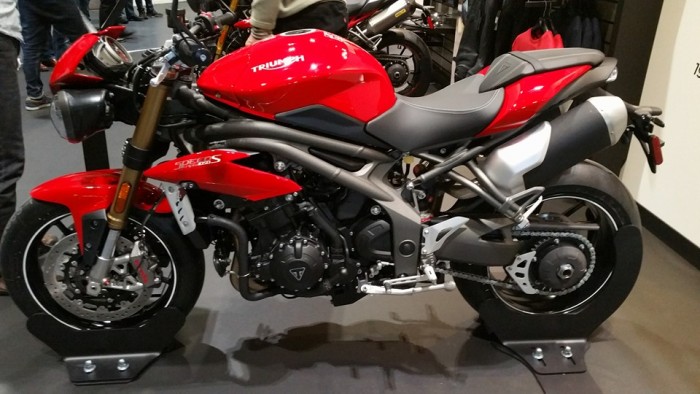
The 2016 changes focus on the Speed Triple’s cosmetics and engine, largely leaving the chassis alone. The frame was entirely new for the bike’s last revamp in 2011, and these prototypes show that it’s not getting big changes for 2016. The suspension is also unaltered, with the base model sticking to Showa while the R retains its more expensive Ohlins forks and shock. The only obvious change is that the standard bike has gained the same Brembo brake calipers as the R.
So, what has been altered? Let’s start with the styling. Almost every bit of bodywork appears to be new, showing an incremental development of the Speed Triple’s styling themes rather than a visual revolution. At the front there’s a new set of headlights, which lose the chrome-rimmed, slanty shape of the existing bike’s units in favour of teardrop-shaped lenses in all-black housings. Above them sits a new instrument cowling incorporating an air intake, although its purpose is unknown since the bike doesn’t appear to have provision for a ram-air system.
One interesting detail is the use of bar-end-mounted mirrors, as on Honda’s new RC213V-S road-going GP replica.
Moving further back there are reshaped side panels and what appears to be a new fuel tank, while the bellypan – only present on the R version in these shots – is also new. The seat and tail are again new, as are the exhaust end cans, which also have reshaped heat shields in brushed aluminium.
But the updates aren’t purely cosmetic, as the 1050cc triple is also heavily revised. The clutch and alternator covers are redesigned but underneath are more significant changes to improve the emissions and ensure that the classic three-cylinder can remain in production for years to come. Earlier information also suggested that the next version of the engine, which is also set to be used in a refreshed Tiger Sport, will gain electronic fly-by-wire throttles to allow Triumph to implement multiple riding modes and traction control.
Power is expected to increase fractionally, perhaps peaking as high as 140bhp, but the real focus is believed to be on the power delivery and emissions.
With an all-new Bonneville and revamped Tiger Explorer also due later this year, Triumph might opt to launch the Speed Triple earlier than usual so it’s not overshadowed, and from these pictures the bike looks very much ready to hit dealers.
source: Bennets.co.uk
Click here to view our range of Triumph Speed Triple parts & accessories
- Published in Motorcycles
2016 Triumph Speed Triple R

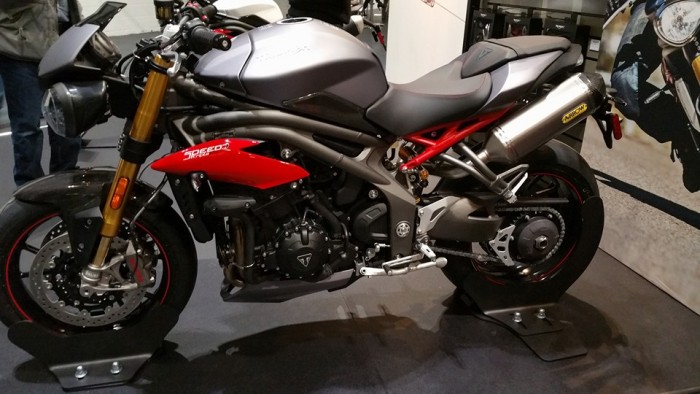
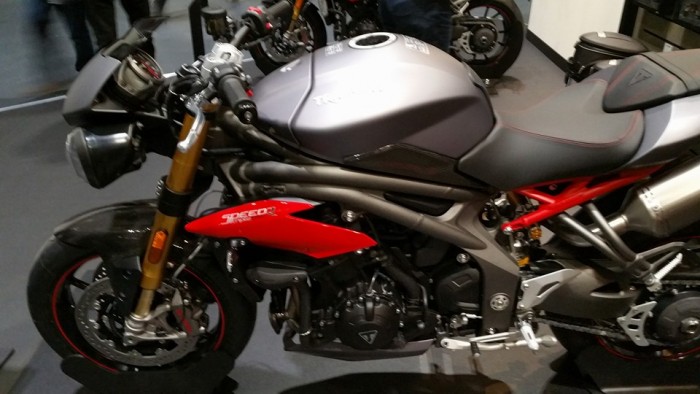
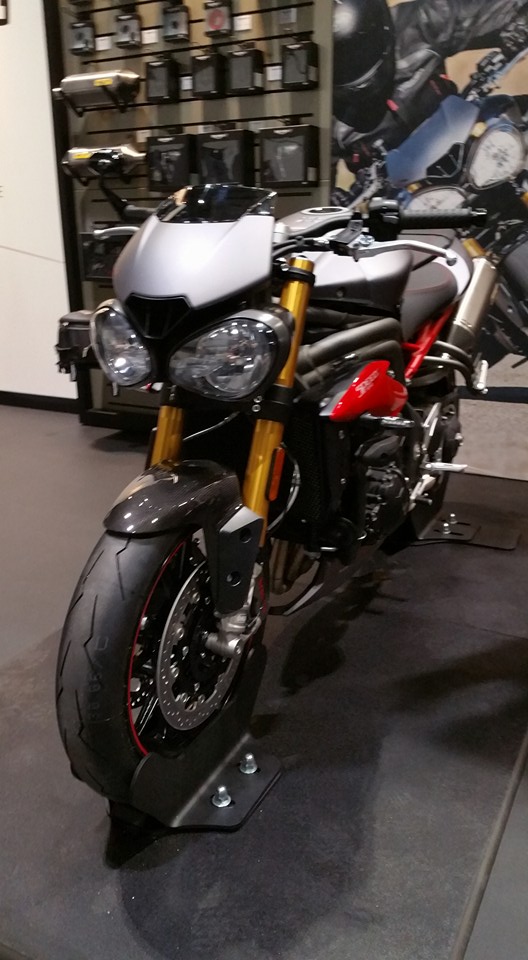
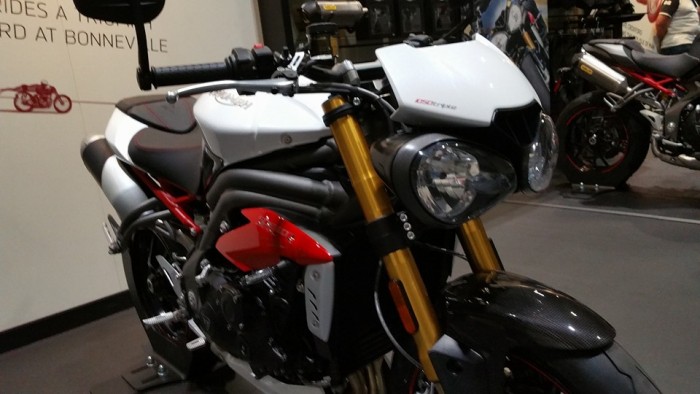
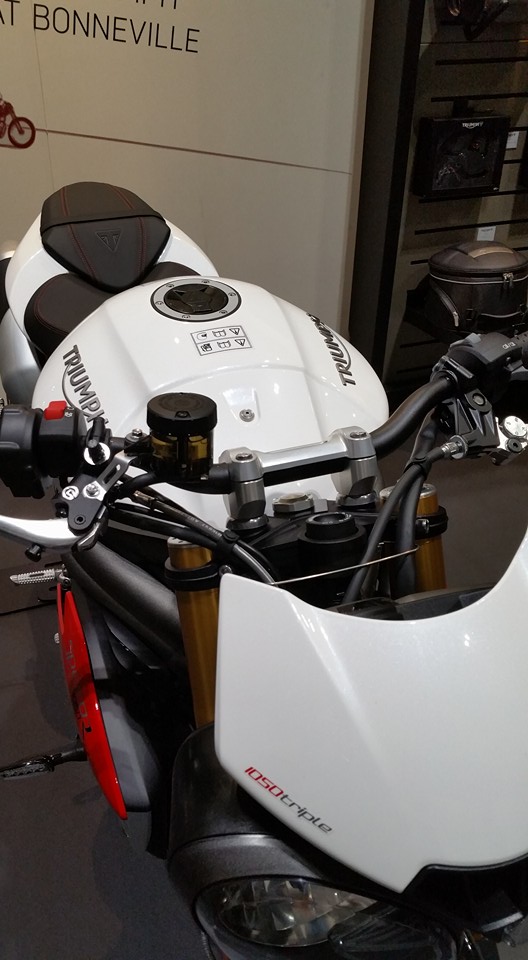
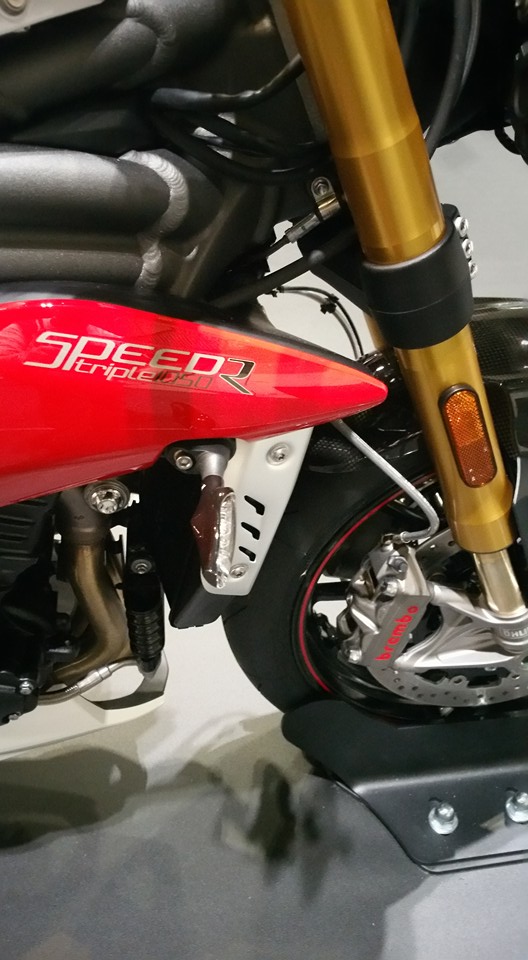
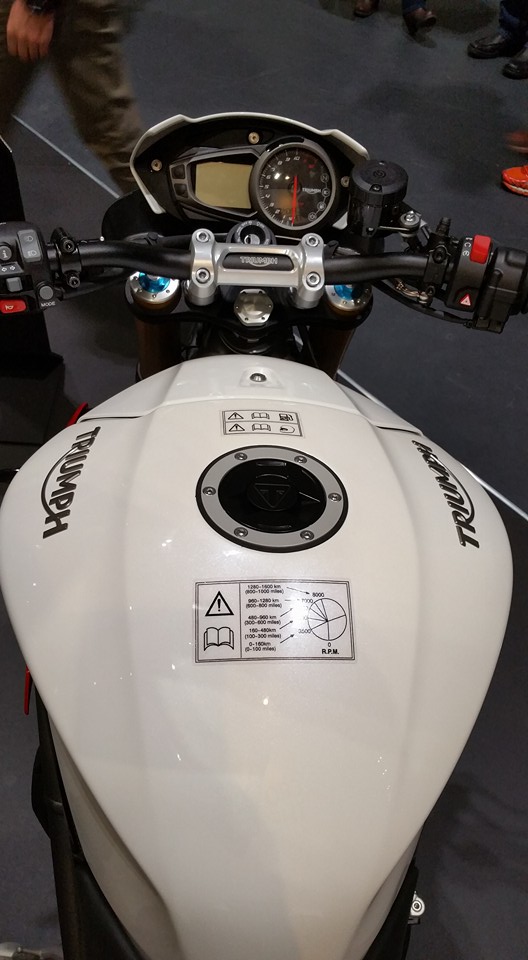
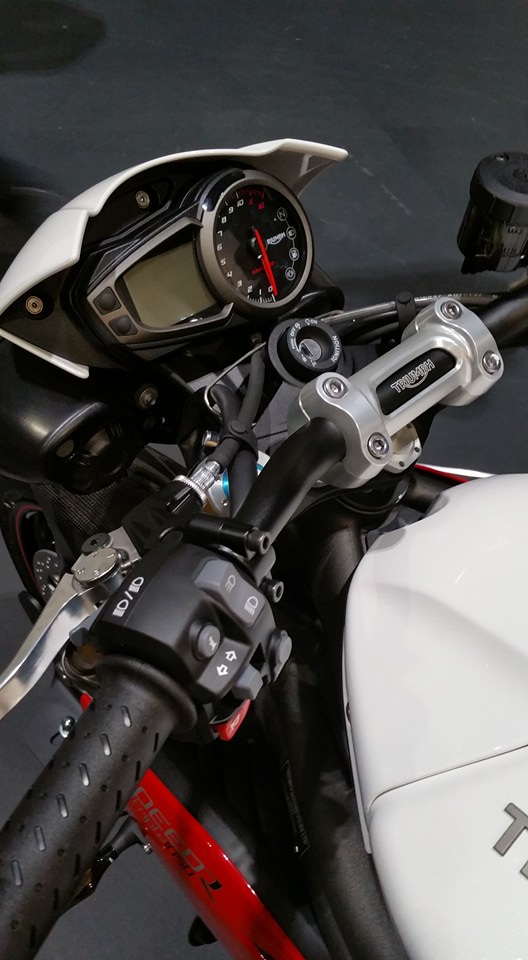
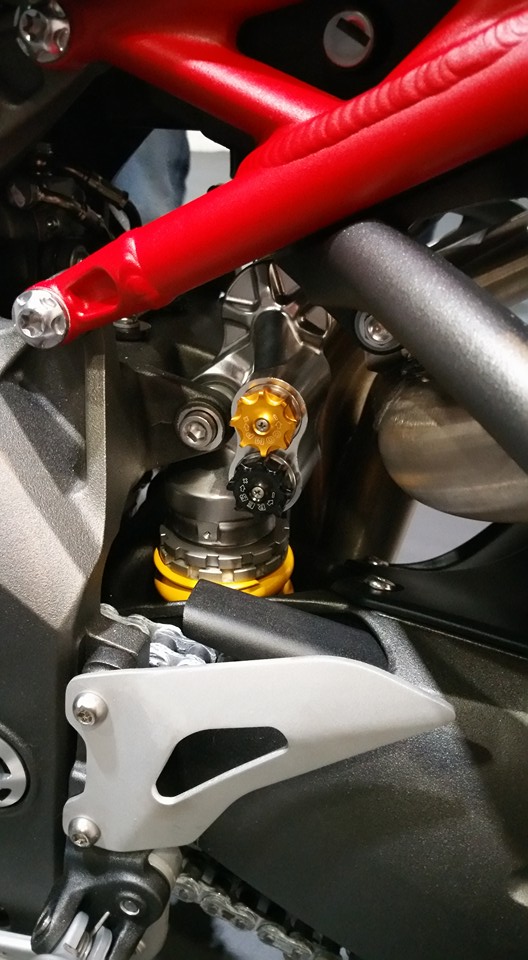
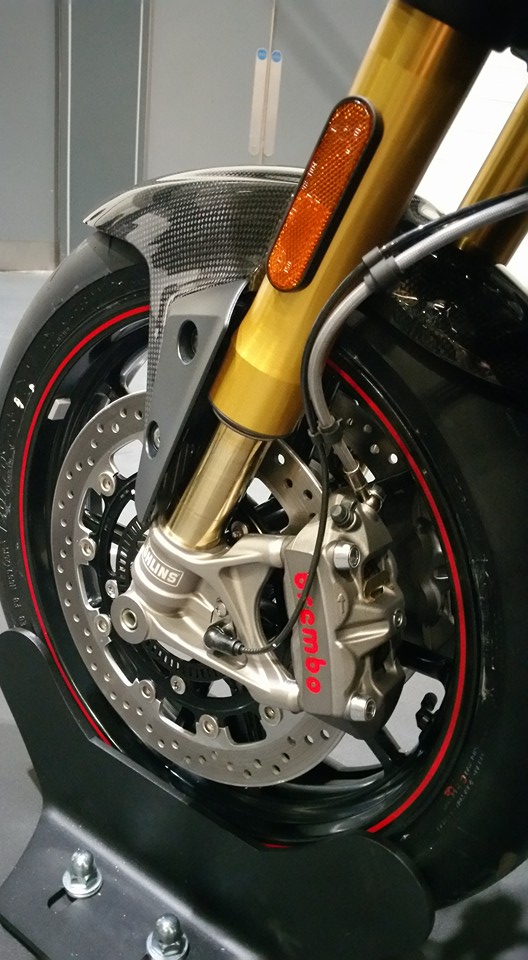

The 2016 changes focus on the Speed Triple’s cosmetics and engine, largely leaving the chassis alone. The frame was entirely new for the bike’s last revamp in 2011, and these prototypes show that it’s not getting big changes for 2016. The suspension is also unaltered, with the base model sticking to Showa while the R retains its more expensive Ohlins forks and shock. The only obvious change is that the standard bike has gained the same Brembo brake calipers as the R.
So, what has been altered? Let’s start with the styling. Almost every bit of bodywork appears to be new, showing an incremental development of the Speed Triple’s styling themes rather than a visual revolution. At the front there’s a new set of headlights, which lose the chrome-rimmed, slanty shape of the existing bike’s units in favour of teardrop-shaped lenses in all-black housings. Above them sits a new instrument cowling incorporating an air intake, although its purpose is unknown since the bike doesn’t appear to have provision for a ram-air system.
One interesting detail is the use of bar-end-mounted mirrors, as on Honda’s new RC213V-S road-going GP replica.
Moving further back there are reshaped side panels and what appears to be a new fuel tank, while the bellypan – only present on the R version in these shots – is also new. The seat and tail are again new, as are the exhaust end cans, which also have reshaped heat shields in brushed aluminium.
But the updates aren’t purely cosmetic, as the 1050cc triple is also heavily revised. The clutch and alternator covers are redesigned but underneath are more significant changes to improve the emissions and ensure that the classic three-cylinder can remain in production for years to come. Earlier information also suggested that the next version of the engine, which is also set to be used in a refreshed Tiger Sport, will gain electronic fly-by-wire throttles to allow Triumph to implement multiple riding modes and traction control.
Power is expected to increase fractionally, perhaps peaking as high as 140bhp, but the real focus is believed to be on the power delivery and emissions.
With an all-new Bonneville and revamped Tiger Explorer also due later this year, Triumph might opt to launch the Speed Triple earlier than usual so it’s not overshadowed, and from these pictures the bike looks very much ready to hit dealers.
source: Bennets.co.uk
Click here to view our Triumph parts & accessories
- Published in Motorcycles
Fullsix Carbon BMW S1000RR Carbon Fibre Parts 2015 – 2016 – 2017
Fullsix Carbon BMW S1000RR Carbon Fibre Parts 2015 – 2016 – 2017
FullSix carbon fiber parts guarantee an excellent appearance and perfect manufacturing. By using state-of-the-art technology and an innovative blend of materials, we assure you that our parts will upgrade your motorcycle both visually and in terms of performance. We have paid particular attention to ensuring that all carbon fiber parts are UV protected through the use of special lacquers, as we know that our customers desire eternal beauty and perfection.
The uniqueness of our products is not just an advertising slogan, but the underlying philosophy of our company itself. Since we believe in providing only the best for your motorcycle, we have developed a unique production monitoring system that ensures that all Fullsix products are manufactured according to the latest protocols and “best-in-the-industry” standards. Through the use of unique barcode technology, CDT Group is the only company in the market that is capable of tracing products through the entire manufacturing process, resulting in products that you can completely trust.
Fullsix stands for perfect looks, precise fitting, outstanding performance and supreme quality.

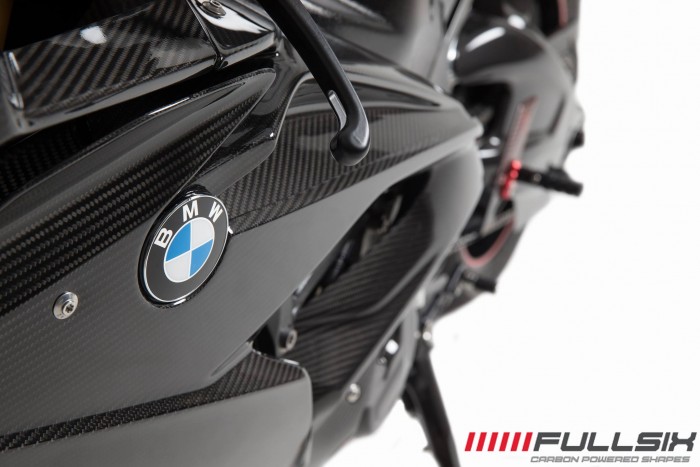
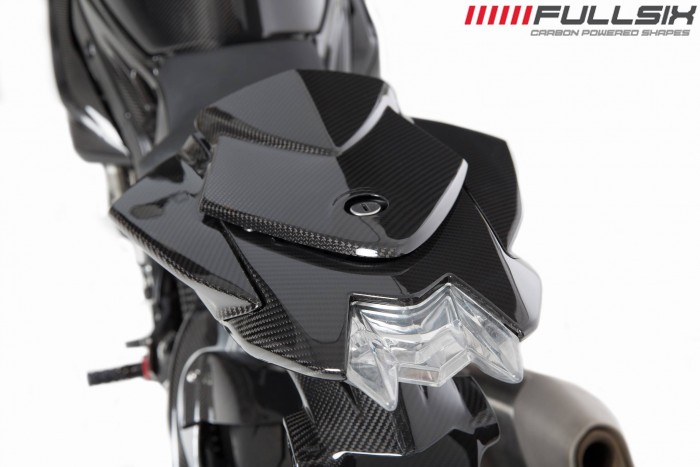
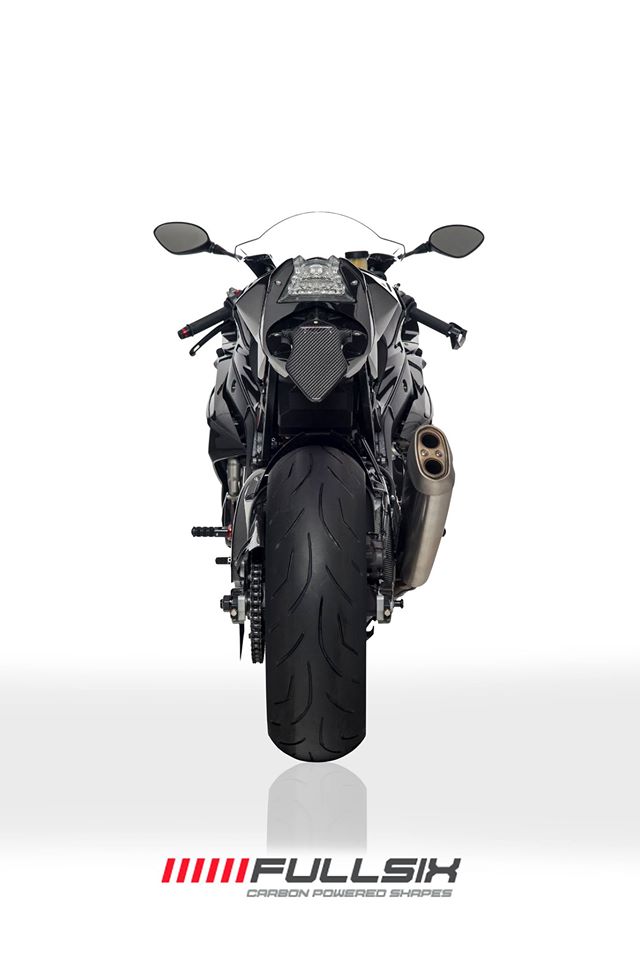
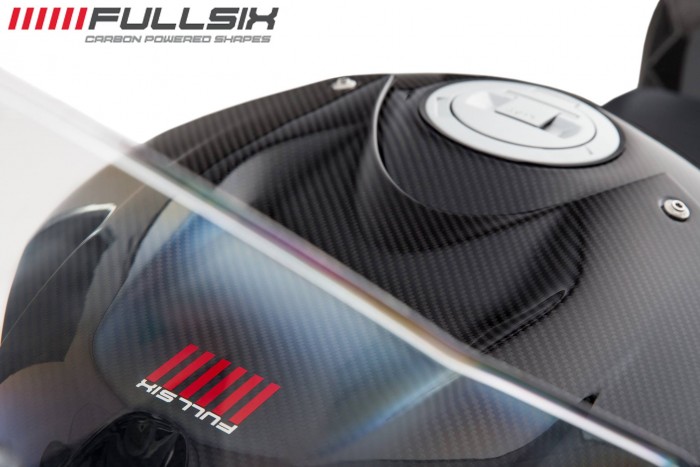
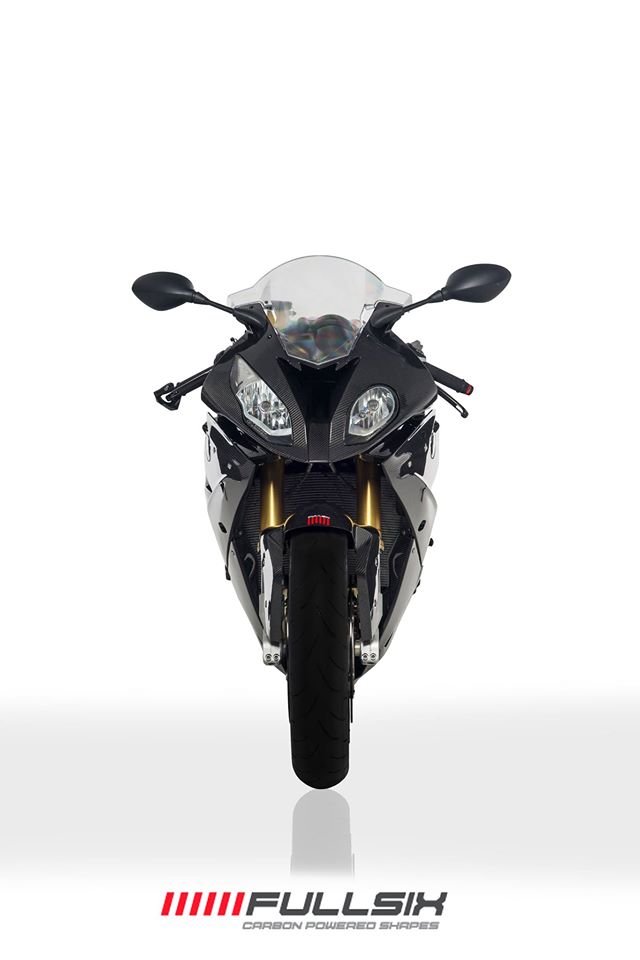
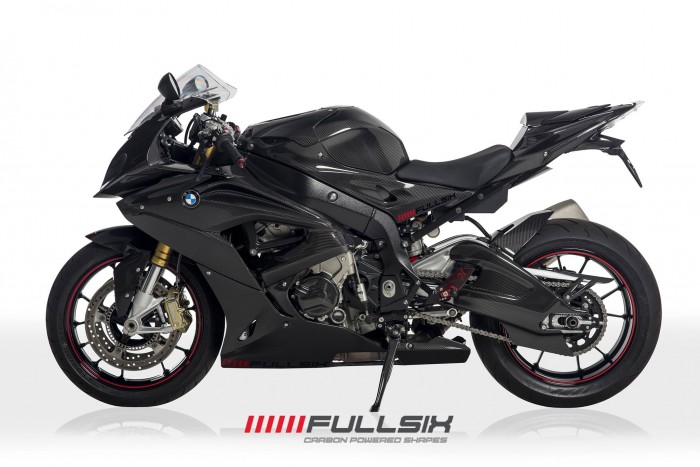

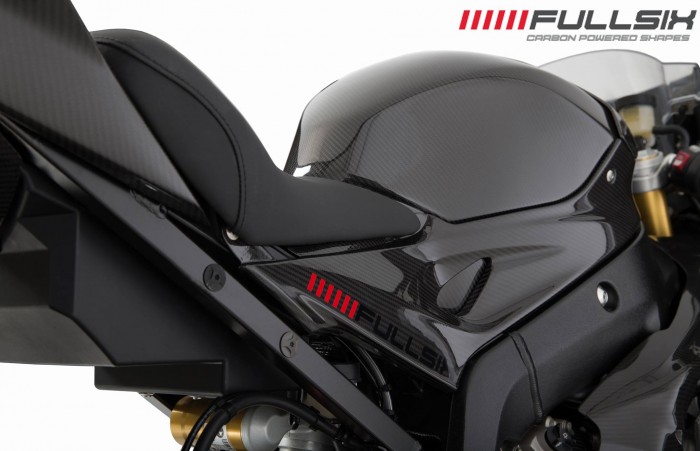
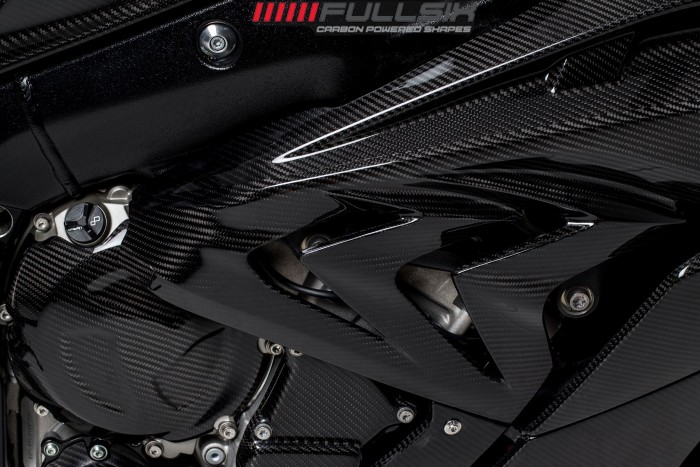
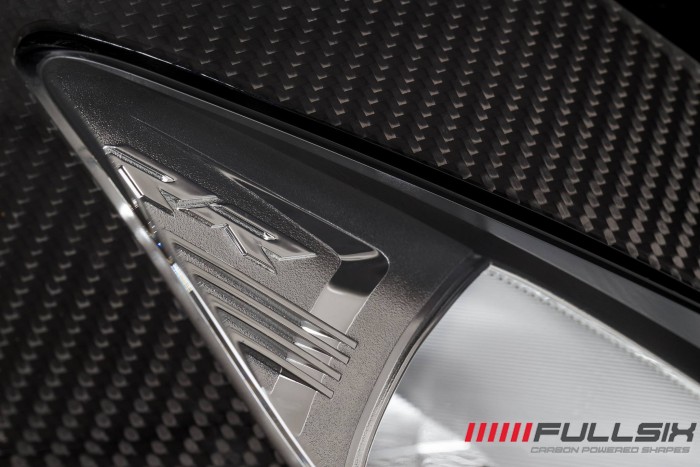
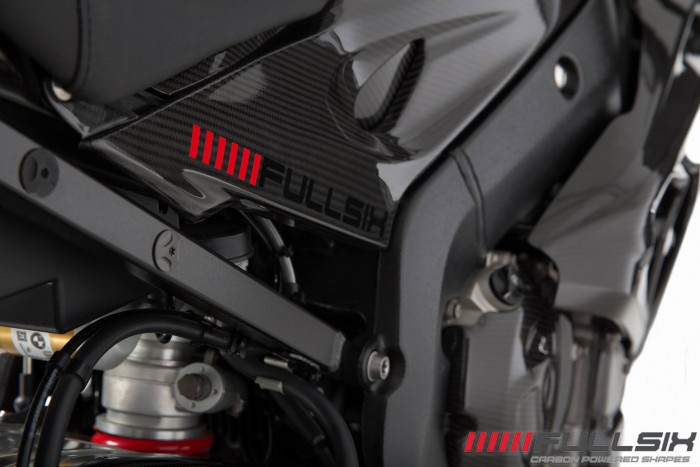
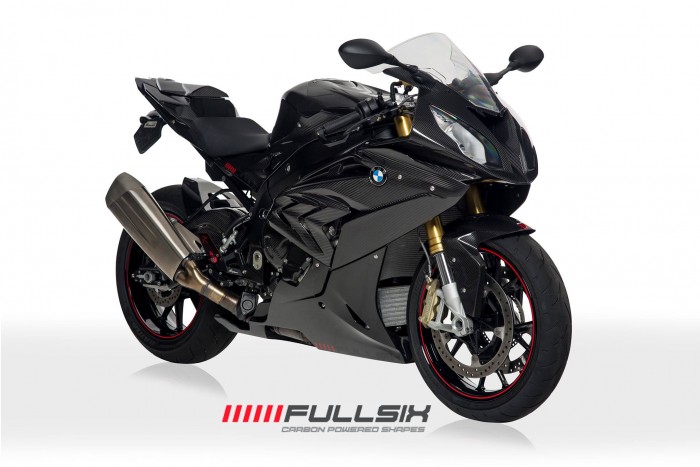
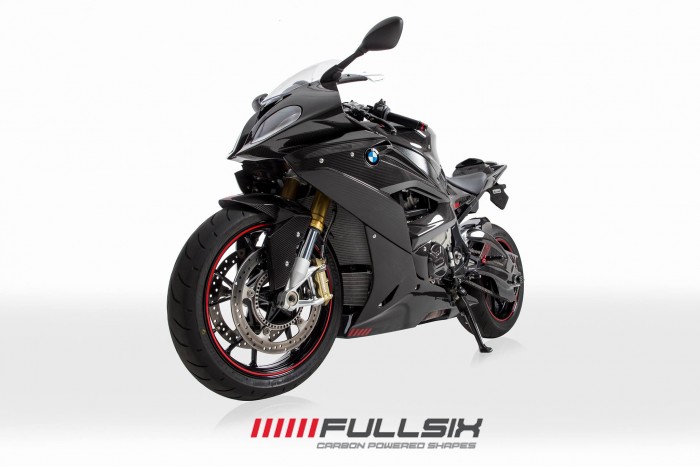
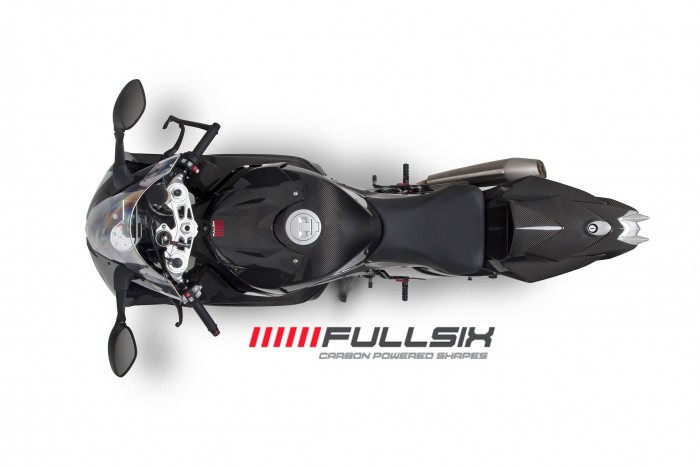
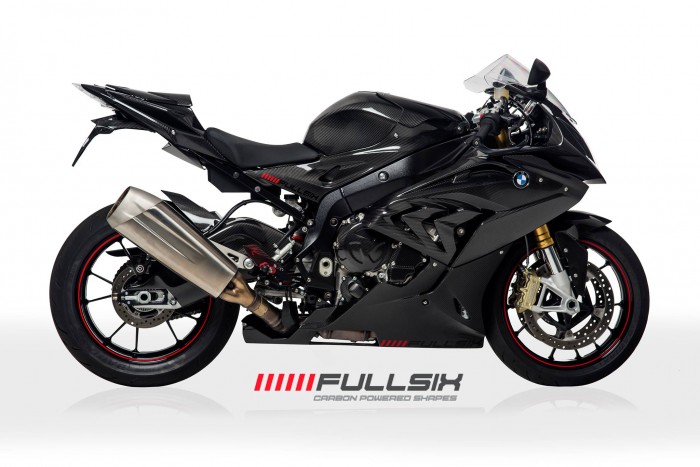
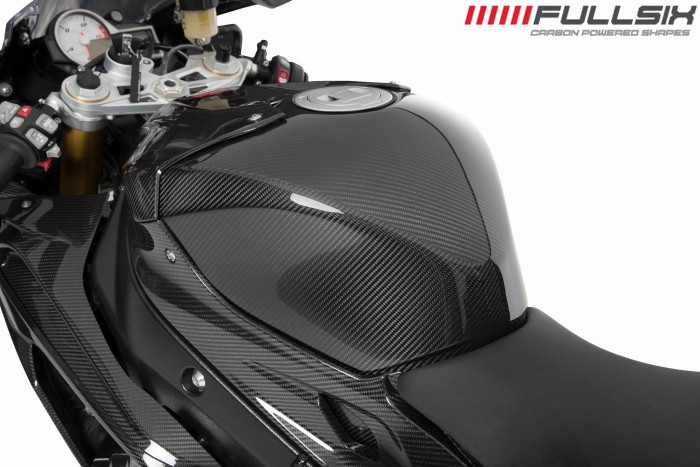
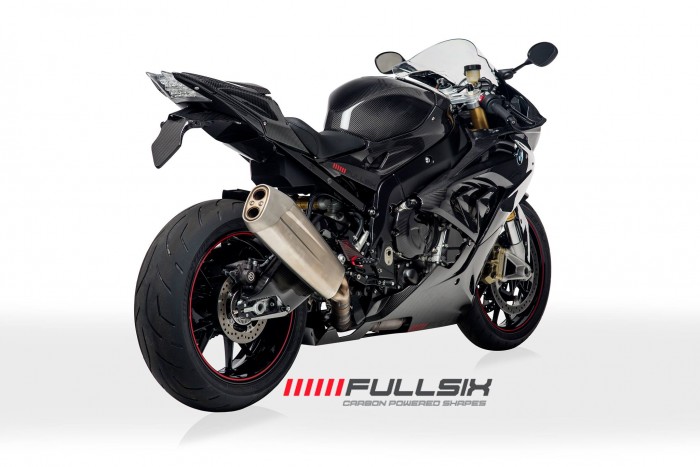

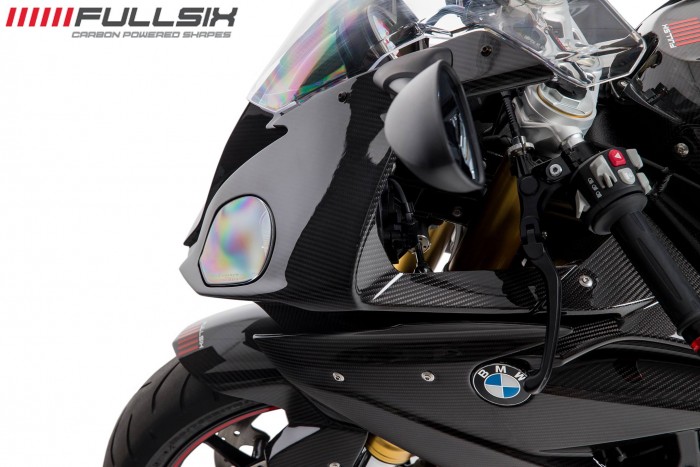
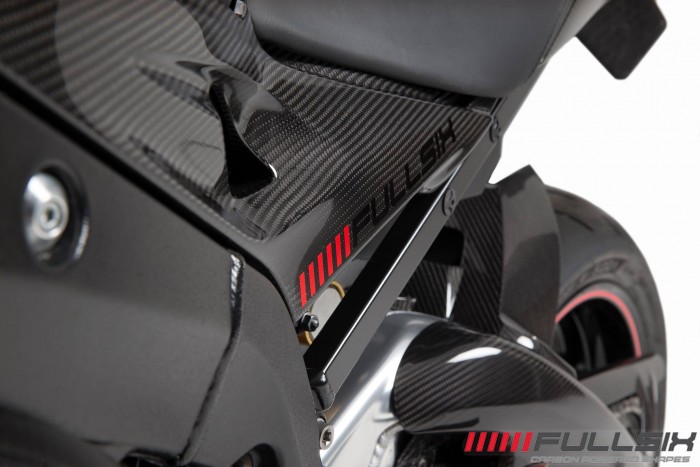

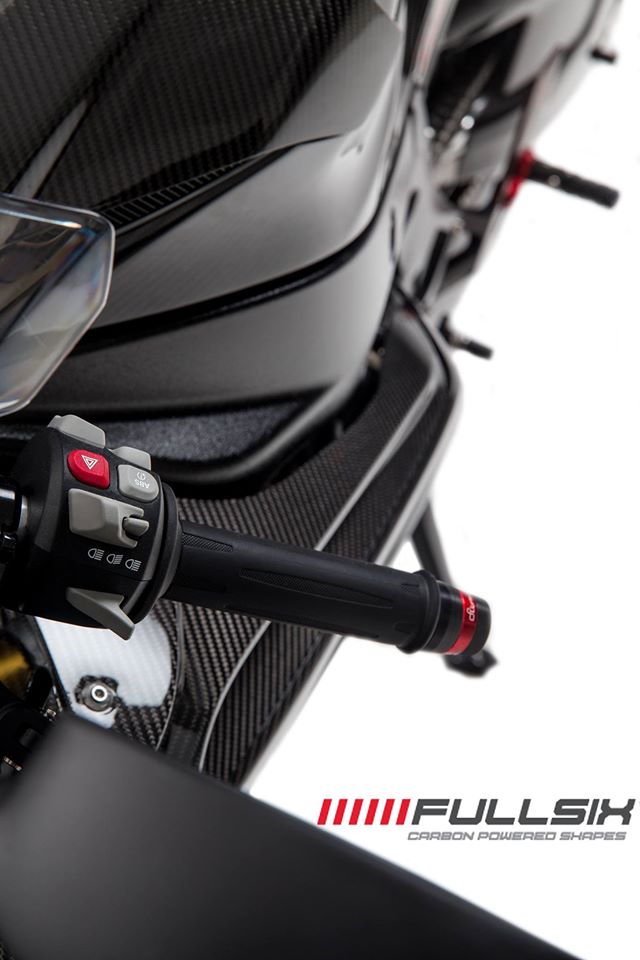
Click here to view parts:
- Published in Motorcycles
Ohlins Ducati Scrambler Rear Shock
Ohlins Ducati Scrambler Rear Shock,
A well proven monotube design, the Öhlins S46 shock absorber sets the standard for performance, quality and endurance.
The S46 Street Performance Line is based on our popular STX46 DR1 shock absorber and developed for naked sports bikes and street performance bikes. It features a large 46mm main piston and an internal gas reservoir within the main body of the shock.
With adjustable damping you can change the behaviour of the shock to suit your taste and even fit a hydraulic spring pre loader to change the stance of the bike. This is the perfect choice for the naked sports bike, or as well call it: Street Performance Line.
Features
- Monotube shock absorber
- Öhlins well proven design
- Adjustable rebound damping and compression
- A range of spring rates available
- Maintenance possibilities
- Optional hydraulic spring pre loader
- Available to a large range of bike models
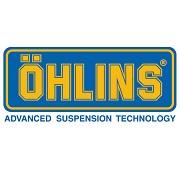
- Published in Motorcycles
MV Agusta 800 Dragster RR Review
MV Agusta 800 Dragster RR Review
“Yes, it goes as well as it looks!”
Overall Rating 4 out of 5
Yes this blinged-up version of the Dragster variant of MV’s 800 Brutale is expensive, but then it’s truly special, too. There are cheaper bikes, more manageable bikes, even faster bikes in the same category but this one is special. And yes, it’s not 100% perfect and certainly not for everyone, but just look at it! And it goes as well as it looks!
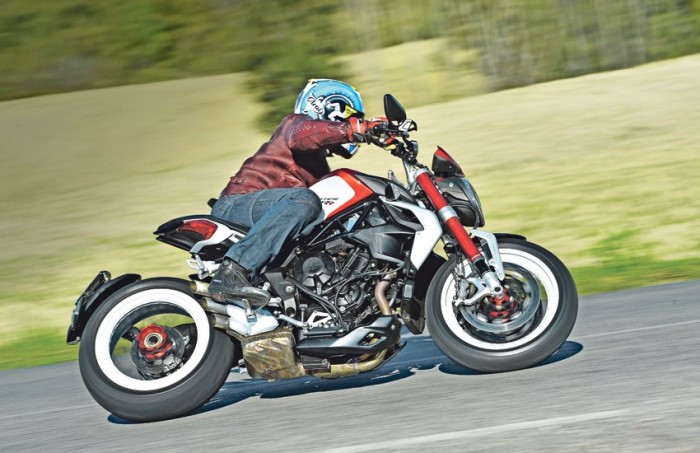
Ride Quality & Brakes 4 out of 5
If the power delivery is a little aggressive, then so is thew Dragster RR’s handling. Twitchy is the word. MV is obviously aware of this and have added a top yoke steering damper. There was never an alarming almighty slap, but I had more than a few twitches on the narrow bumpy Italian roads. The wheelbase is short, it’s a light bike with a firm set up and lots of power, it was always going to be a little lively.
My only other gripe was the ride is on the firm side. I got thrown out of the seat on the odd occasion, the bars shake a little and you get hammered by the hard forks which aren’t absorbing the huge bumps. In MVs’ defence the roads were really bad and I was hitting them hard like a Greyhound that had just been released from the trap, I simply couldn’t ride slowly. On smoother roads it worked far better.
Engine 4 out of 5
MV have upped the triple’s performance from 125bhp to 140bhp by increasing the size of the air-box, improving the exhaust flow but more importantly revising the fuelling, which now with two twin injectors per cylinder. They’ve also tried to smooth out the power delivery amd make the torque more linear, which was a criticism of the old bike and they’ve done just that.
The old 800 had bags of attitude but was hard work and aggressive. But this engine is a peach. Fire up the 800cc triple and there’s a real rasp. It sounds lovely, revving quickly with aggression. Combine that with clutchless gear changes and intoxicating noise it’s hard not to thrash it. You end up attacking roads not riding them.
“Click the link below to visit our MV Agusta shop!”
Build Quality & Reliability 5 out of 5
These pictures don’t really do the bike justice, you have to see it in the flesh to get the full impact; but be warned you’ll want one. The finish is outstanding, the paintwork looks handcrafted, the top yoke is lovely. Imagine casting an admiring glance over this MV every time you open your garage door, you’d smile every time
Insurance, running costs & value 3 out of 5
There’s no getting away from the fact that this is a helluva lot of money for ‘only’ an 800. But there’s also nothing else quite like it (although the Brutale version is a little cheaper and possibly more useful). Possibly the ultimate middleweight poster bike. Insurance group: 17 of 17
Equipment 4 out of 5
There’s not just three rider modes; Rain, Normal and Sport, there’s a quick-shifter, traction control, slipper clutch and top notch cycle parts everywhere you look, such as the amazing Brembo stoppers which lure you into taking huge liberties. Straight line braking is immense; just grab a handful of lever and let the electronics do all the work.
It’s impossible to lock either wheel and impossible to stoppie, you won’t be thrown over the bars due to the rear wheel lift intervention. It’s one of the best braking bikes on the market, period.
By Adam Child
Source: MCN
- Published in Motorcycle Review
Ducati Scrambler Review
Ducati Scrambler Review
“Stylish, easy to ride, desirable and affordable”
Overall Rating 4 out of 5
You don’t have to be a fashionable hipster to enjoy the new Ducati Scrambler, its qualities shine through without the clever marketing. It’s easy to ride, small and light, has a lovely useable air-cooled V-twin with lots of low to mid-range power. There’s some lovely attention to detail, it’s stylish and, at under £7000, an affordable Ducati. Experienced hands may want a little more power and noise, but everyone else will love it.
Ride Quality & Brakes 4 out of 5
Despite the odd wheel sizes (18 inch front and 17 rear) and off road-looking Pirelli rubber, the Scrambler can hold its head high and punch well above its weight in handling terms. It’s relatively light and nimble and the wide, retro bars enable you to throw it around with ease.

Engine 4 out of 5
There’s an all-new 803cc, air-cooled, motor which is based on the old 796 Monster unit. The bore and stroke has remained the same but valve overlap, injectors, air-box and exhaust are all new. The result is 75bhp and 50.2ftlb of torque – slightly down on the old Monster but the spread of torque is greater. Power starts from low down, is linear, more than enough for this type of bike, but it does lack a little top end rush for experienced hands.
Build Quality & Reliability 4 out of 5
The level of finish is very high considering the price – there is some lovely attention to detail. Ducati have also worked in partnership with reliable quality brands like Brembo, Pirelli and Kayaba. Reliability shouldn’t be a problem as the motor is based on the proven 796 Monster.
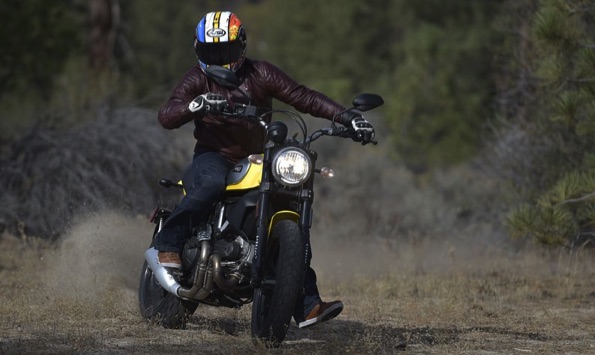
Insurance, running costs & value 5 out of 5
The base Icon comes in at under £7000 which is exceptional value for money for a desirable, quality, good looking Ducati. In many ways it doesn’t feel like an entry level ‘budget’ Ducati, you’d estimate the price to be much higher.
Equipment 4 out of 5
ABS comes as standard but that’s it in terms of rider aids. It’s relatively basic but is designed to be at a competative price. The Kayaba suspension only has pre-load adjustment, and there’s only a single brake disc up front, but it’s controlled by a huge radial Brembo caliper.
Source: MCN
Click on the link below to view our Ducati Scrambler parts
- Published in Motorcycle Review
Kawasaki’s New BATTERY ZX-10R revealed in AMAZING patent drawings!
Kawasaki’s New BATTERY ZX-10R revealed in AMAZING patent drawings!
By Tony Carter and Leon Rose
What do you think to this Kawasaki BATTERY ZX-10R that hinges the ‘engine’ unit out of the left side of the machine in one unit?
The jaw-dropping idea, outlined in official FACTORY patent drawings recently filed, shows how the entire power unit can be opened up from the bike itself and replaced with a fully-charged unit, or have maintenance carried out as needed.
The drawings show crucial parts of the design in order to make this work. Based on a ZX-10R chassis, it is clear to see that everything will stem from this hinge design.
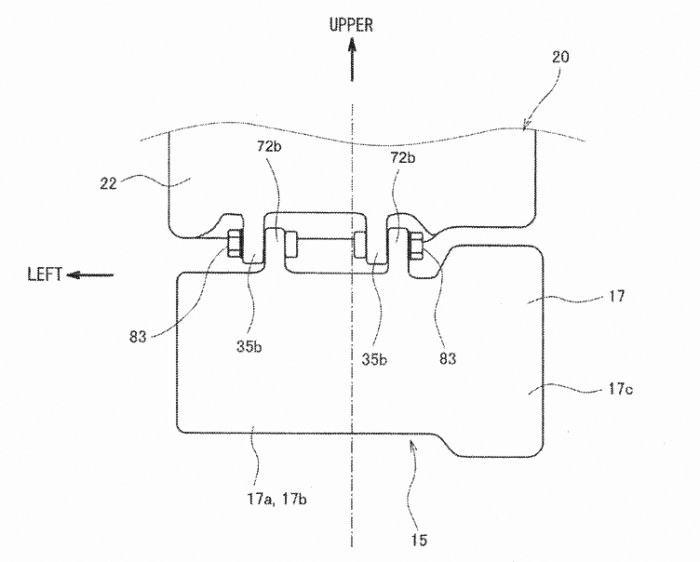
That hinge is figured in most of the drawings for this new motorcycle, you can clearly see how the frame will hinge around this point in the drawing below – the hinge element is number 82 (52,53) on the drawing (top left shoulder of the bike) which shows how the whole left hand side of the frame will open up and allow the entire motor to exit the motorcycle without the need for tricky loading or unloading from the frame.

From the top-view drawing (below) it’s clear that the overall dimensions of the bike will remain the same, what is clear that the electric lump in the middle, which will carry a stack of batteries, is a self-contained unit feeding into the gearbox and conventional chain drive.
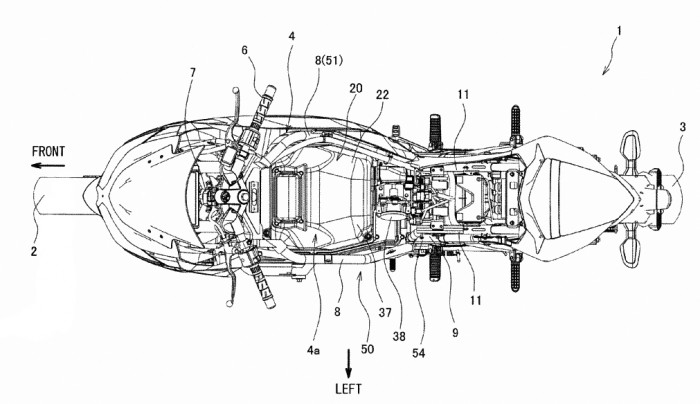
The next picture in the run of patents describes the all-important, very strong, battery tray. This sits at the bottom of item numbered 32 in the side-on image of the full bike and carries most of the pivotal weight of the battery unit as it swings out of the engine area.
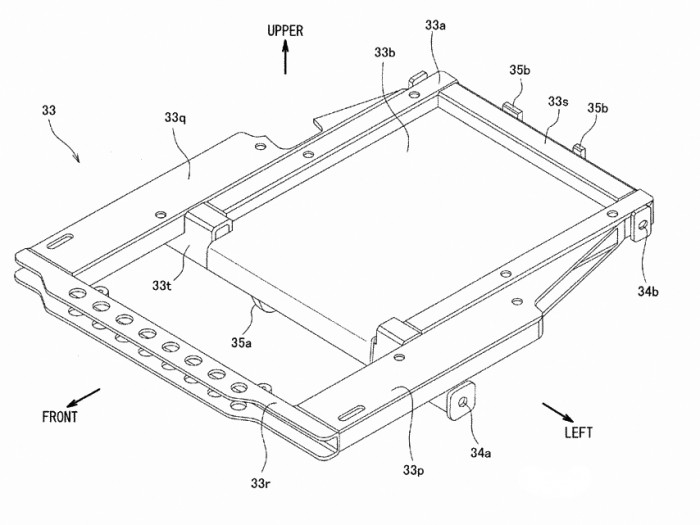
Another drawing shows the frame in isolation with the hinge system clearly visible (this is the upper noted 52(53), there is a clear, strengthened shoulder to the frame with an outer brace of tubing just to the right of the hinge, and another below the hinge, in order to support the weight of the battery packs. The lower noted 52(53) and 54 shows how the frame is attached to the outer lower part of the bottom of the frame – this is to allow the entire frame to hinge out and back into place where it is secured again before the bike can be ridden.
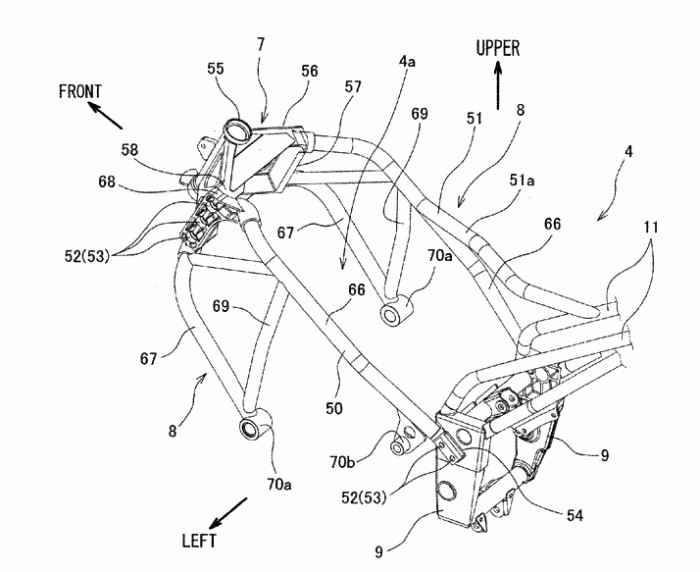
Those outer braces are also described in the following image, which is the front of the frame shown facing out of the page, the part of the frame’s shoulders (and the frame) which moves is on the right hand side of the image – items 67,8,66 and 51 point to the moving part of the frame.
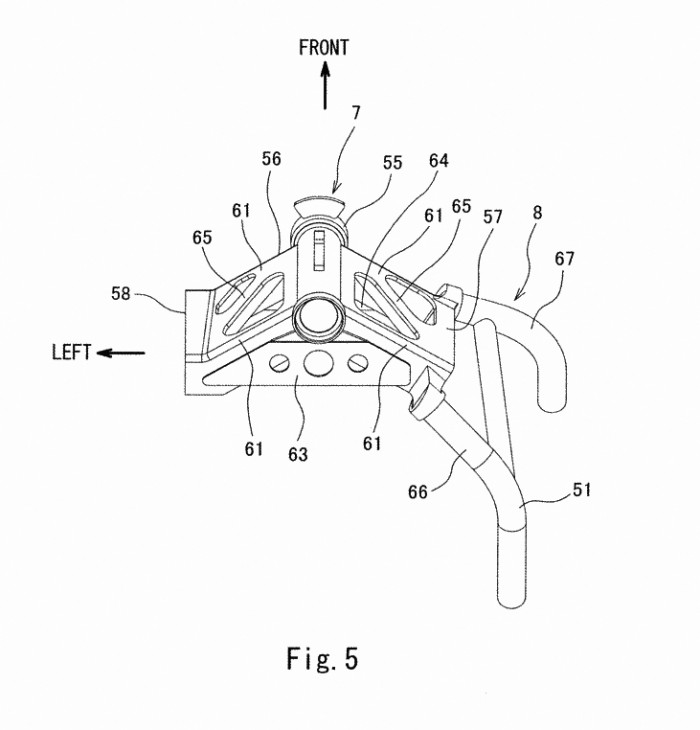
This image below is the completed idea sited in position with the battery component elements hinged out of the bike and on to a stand that sits alongside the bike. This means that the bike will effectively park next to the stand and the battery compartement would be hinged out for replacement with a full-charged unit, seriously cutting down – or possibly even negating – the need for time spent waiting for the bike to be recharged at all. Like filling up a motorcycle now with petrol, this could lead to a series of already-charged battery stores in special ‘charging stations’ where a rider can just pull up and within a couple of minutes have a new, fully-charged power unit fitted into their bike.

Another image shows this but from the front perspective and without any connecting leads in place. This image is used to show proportion of the battery engine unit in comparison to the overall motorcycle – what’s important to notice here is that with the motor out of the bike there is nothing engine or chassis-wise visible on the right hand of side of the motorcycle from the front.
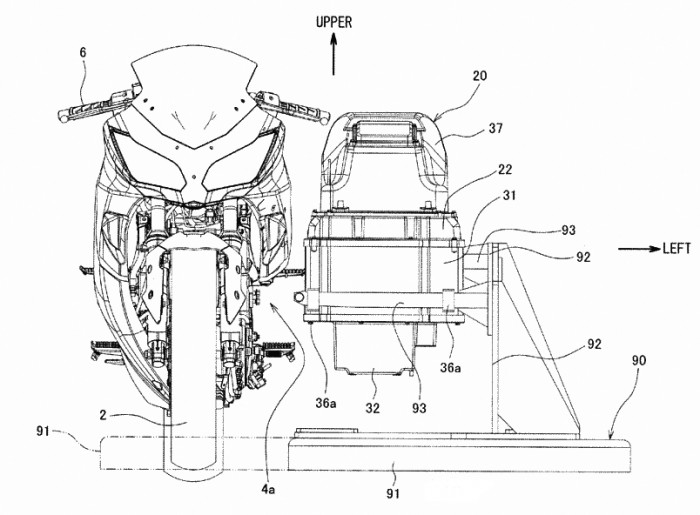
What is also intriguing in the above drawing is element 91 which is an extension of the frame’s base which holds the batteries out of the bike. The extension is there to effectively catch and support the bike’s front wheel – like a moving choc block that is ready to catch the front wheel initially and once the new battery is in the bike and the rider is back on the bike it will slide back into the base to allow the bike to be ridden away – if the system is used outside and the bike needs to be in the right position for an automatic engine-battery-swap. What that could mean is that what we’re looking at here is essentially the fuel-pump-for-the future where you ride into the choc and leave the bike upright as a machine automatically swaps the battery unit for a fully charged one.
- Published in Motorcycles
The next Ducati Superbike will be a V4
The next Ducati Superbike will be a V4

Desmosedici GP will become Ducati’s Superbike father from 2018, so long V2, so long Superquadro.
Is an ‘official’ rumor that 2018 will mark the first real Superbike with a V4 engine (Desmosedici RR is an exotic) from Ducati.
The angle will remain 90 degree and the frame will be for sure the perimetral type.
Gigi Dall’Igna’s actual Moto GP project will finally be used 100% as a platform for a street bike development.
It’s interesting to see if Ducati will still keep a V2 engined superbike in it’s offer and, in this case, if will do it, if they’ll coma back to the trellis frame – as they won;t use it anymore in WSBK and not needing certain values for rigidity / performance / weight.
We’ll see about the V Twin SBK, but what is a certain thing now, the next generation Ducati Superbike will be a V4.
Source Ducatibog.net
- Published in Motorcycles
Ducati Panigale 1299 Carbon Fibre Parts Accessories
Ducati Panigale 1299 Carbon Fibre Parts Accessories
Click here to visit shop
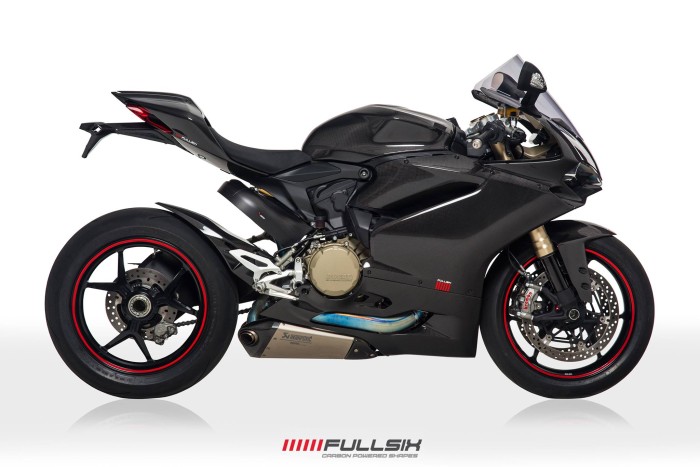
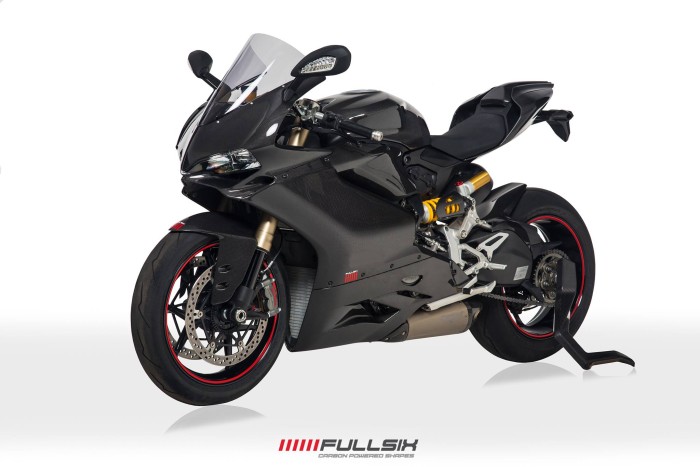
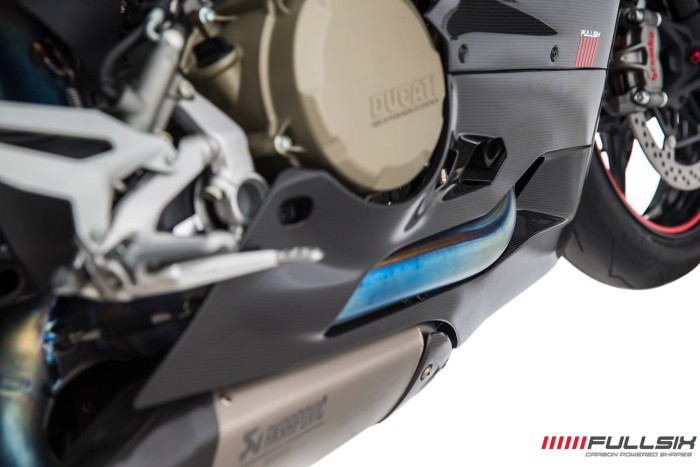
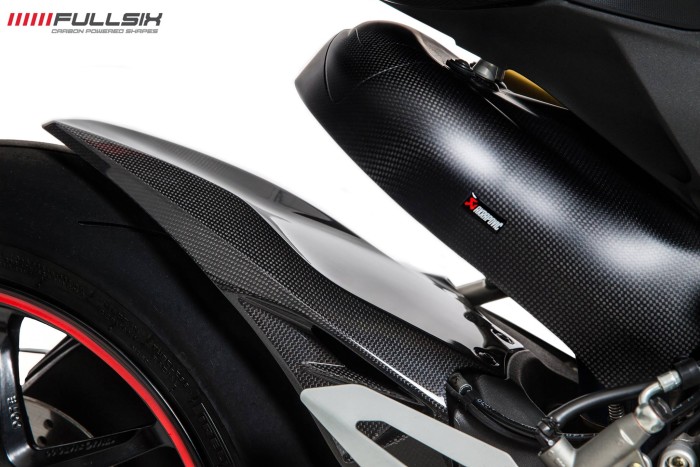
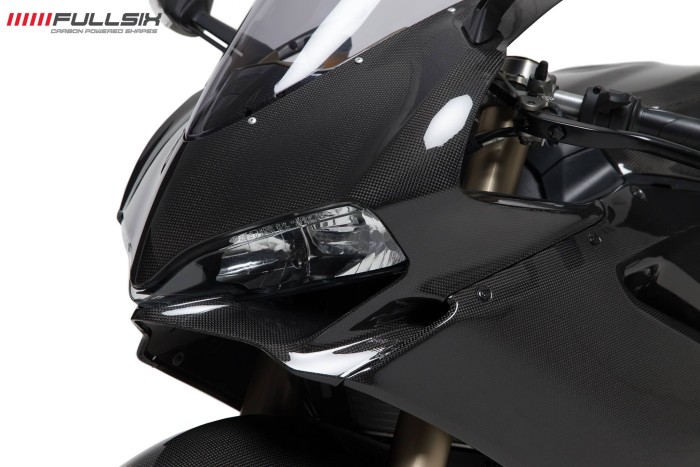
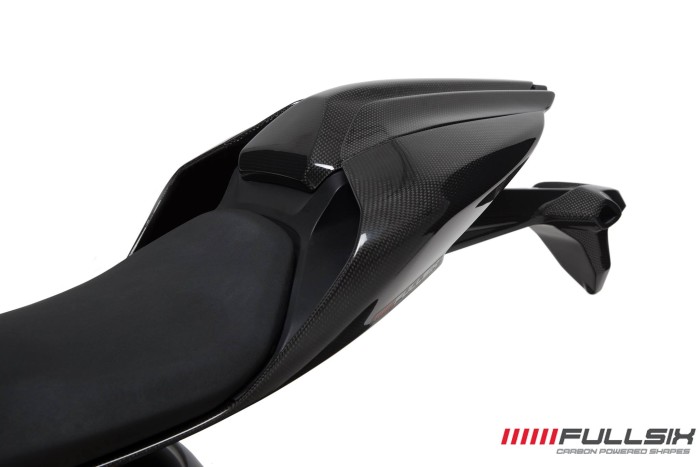
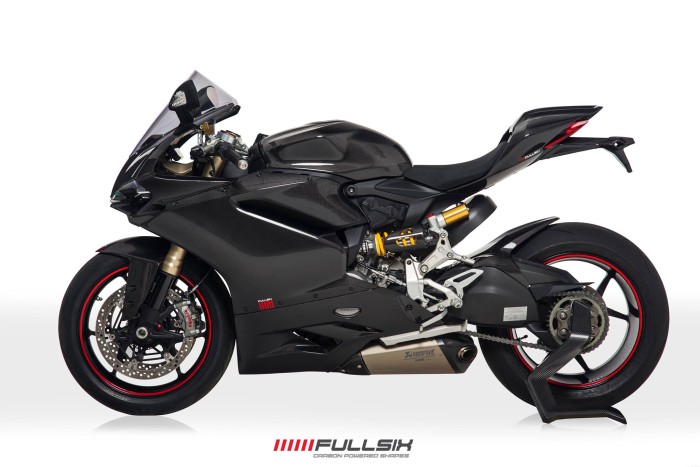
- Available in gloss or satin finish.
- Autoclave production
- Select Gloss or Satin/Matte finish
- 100% carbon fibre
- UV treated
- 100% fitment guarantee
- Fit extremely well as in no drilling or dremelling
- Light yet rigid and strong
- Consistent weave
- No pinholes in the finish
- Nanotechnology to produce superior parts
Fullsix carbon fibre parts guarantee an excellent appearance and perfect manufacturing. By using state-of-the-art technology and an innovative blend of materials, we assure you that our parts will upgrade your motorcycle both visually and in terms of performance. We have paid particular attention to ensuring that all carbon fibre parts are UV protected through the use of special lacquers, as we know that our customers desire eternal beauty and perfection.
The uniqueness of our products is not just an advertising slogan, but the underlying philosophy of our company itself. Since we believe in providing only the best for your motorcycle, we have developed a unique production monitoring system that ensures that all Fullsix products are manufactured according to the latest protocols and “best-in-the-industry” standards. Through the use of unique barcode technology, CDT Group is the only company in the market that is capable of tracing products through the entire manufacturing process, resulting in products that you completely trust.
Fullsix stands for perfect looks, precise fitting, outstanding performance and supreme quality.

- Published in Motorcycles


